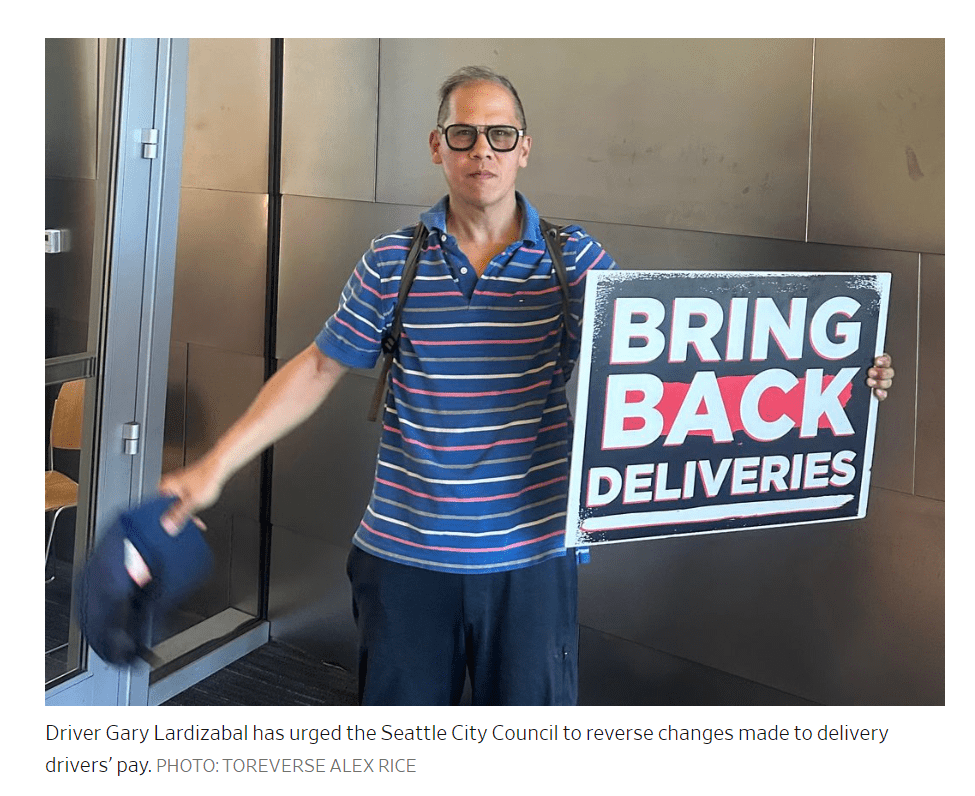Drivers are not helped by wage mandates is Seattle and New York. And customers complain higher prices and cold food. It’s a perfect trifecta of complaints.

Neither drivers nor customers are happy with misguided politicians attempting to help driver get better pay.
It’s losses all around as Delivery Drivers Got Higher Wages. Now They’re Getting Fewer Orders.
The delivery companies—whose businesses are built on gig workers they don’t employ full- time—say they can only afford to pay so many workers under the two cities’ latest pay standards. The cities want the companies to pay couriers a minimum hourly wage based on the time they spend delivering orders and reward the most efficient workers. New York City now requires that the companies pay couriers at least $19.56 per hour before tips, up from an average of $5.39 per hour before its rules went into effect in December.
Uber Eats’ UBER orders in Seattle fell 45% last quarter from the same period a year earlier after the company imposed a $4.99 fee on each order to cover the city’s new pay requirements. Demand also cooled in New York City, Uber and DoorDash DASH.
Consumers already pay the apps a service fee and delivery fee, in addition to tipping workers. For some, the latest app fees were the last straw.
Seattle-based researcher Ro Singh was hooked on ordering in several times a week until the city adopted its pay measure in January. App prices “became absolutely nuts,” he said, after adding varying delivery fees in addition to tipping. He started picking up the food himself.
“It’s like double the price to order a $20 burrito now” compared with the pickup price, he said. “This is insane.”
Uber Chief Executive Dara Khosrowshahi said the company has had to cut 25% of the delivery drivers who previously worked for the app in New York City. “So far, regulation has definitely hurt the people that it’s supposed to protect,” Khosrowshahi said last month on a call with analysts.
Shuai Zhang, the owner of Poprice, an Asian street-food restaurant in New York City, says his delivery sales are a third of what they were before the changes. Drivers who once picked up from his restaurant are now asking him for jobs. He hired two of them.
Fewer workers delivering for the apps means it takes longer to pick up orders. Customers are complaining about deliveries arriving cold and soggy, Zhang said. To make up for lost sales, he has started working as a restaurant consultant.
Seattle driver Gary Lardizabal said he makes less money now despite working more hours. Breakfast and afternoon-snack delivery orders have disappeared. Smaller deliveries don’t make sense because of the new $4.99 fee, he said.
Perfect Trifecta of Who Is Unhappy
- Drivers because they are making less money
- Restaurants because they are losing business
- Customers because of slower deliveries, cold food, and higher prices
The city loses too. Seattle collects a sales tax of 3.85 percent.
Seattle vs New York
New York City says the plan is working. The only thing I can come up with is reduced traffic.
Seattle City Council President Sara Nelson is pushing to reverse the new earnings standard after complaints from drivers, restaurants and consumers, though she wants to ensure that workers still make the city’s minimum hourly wage before tips.
What a hoot.
Not having learned anything from this, Nelson still wants to mandate minimum wages. I wonder what miserable failure she will concoct next.
Price Wars at McDonalds, Starbucks, Walmart, Target
Meanwhile, please note A $5 Meal Deal at McDonalds, Price Wars Also at Starbucks, Walmart, Target
Still more signs of consumer exhaustion are evident in tactics by McDonalds, Starbucks, and other chains’ attempts to woo back customers who said no more to rising prices.
Breadsticks at Olive Garden Highlight Financial Strain on America’s Middle Class
In case you missed it, please see my June 20 post, Breadsticks at Olive Garden Highlight Financial Strain on America’s Middle Class
Traffic at Olive Garden is up 3.9 percent but but same store sales are down 1.5 percent. Are people filling up on unlimited breadsticks? Drinking less wine?
Discretionary Spending
Repeating comments I made in the McDonalds post, all of the articles in this post have one thing in common. They are all about discretionary spending.
Consumers are tapped out and that is the first, if not only thing consumers can cut back on.